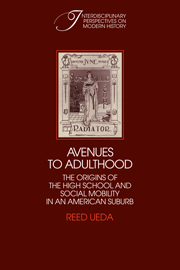Book contents
- Frontmatter
- Contents
- Acknowledgments
- Introduction
- 1 Farm village to commuter suburb
- 2 The evolution of educational leadership
- 3 The free high school
- 4 The rise of Yankee city and the prolongation of schooling
- 5 Popularizing high school: “the college of the people”
- 6 The origins of high school youth culture
- 7 Educational opportunity and social mobility
- 8 The birth of progressive reform and the junior high school
- Conclusion: The high school in the light of history
- Appendix I Courses of study
- Appendix II Sources and methods
- Appendix III Students and households
- Appendix IV Supplementary household data
- Notes
- Index
7 - Educational opportunity and social mobility
Published online by Cambridge University Press: 04 August 2010
- Frontmatter
- Contents
- Acknowledgments
- Introduction
- 1 Farm village to commuter suburb
- 2 The evolution of educational leadership
- 3 The free high school
- 4 The rise of Yankee city and the prolongation of schooling
- 5 Popularizing high school: “the college of the people”
- 6 The origins of high school youth culture
- 7 Educational opportunity and social mobility
- 8 The birth of progressive reform and the junior high school
- Conclusion: The high school in the light of history
- Appendix I Courses of study
- Appendix II Sources and methods
- Appendix III Students and households
- Appendix IV Supplementary household data
- Notes
- Index
Summary
The students of Somerville High School at the turn of the century absorbed new experiences from the classroom and peer group that they knew would affect them for the rest of their lives. For many the high school was a place of self-discovery where they learned about their potentiality for the first time. “Perhaps there in the old school,” wondered a graduate of the class of 1904, “the pupil caught the first glimpse of his power, his work in life; possibly there he first realized what he could do.”
The coursework pushed students into new terrains of knowledge and habits of thought. The serious scholars learned the study techniques that enabled a majority of the preparatory graduates each year to enter college. They were drilled in class but they had to have the initiative to perform their homework. As George Whipple recalled, “We had received a training in the fundamentals of education and had learned how to study.… We were put on our own responsibility; that developed self-reliance.”
The scholars also acquired a new sense of educational ambition. Each new class of freshmen was aware that they had a tradition of achievement to uphold when they entered Somerville High School. George Whipple remembered how “From our mathematics room we could look down upon the tower of Harvard Memorial Hall and upon the red roof of Sever Hall, where we were to take examinations the coming June – a view of the gateway to the Promised Land, which kept us ‘keyed up’ in our efforts to reach it.” Whipple reminisced proudly, “Five boys generally entered [Harvard College] from the Somerville High School every year.
- Type
- Chapter
- Information
- Avenues to AdulthoodThe Origins of the High School and Social Mobility in an American Suburb, pp. 153 - 185Publisher: Cambridge University PressPrint publication year: 1987



